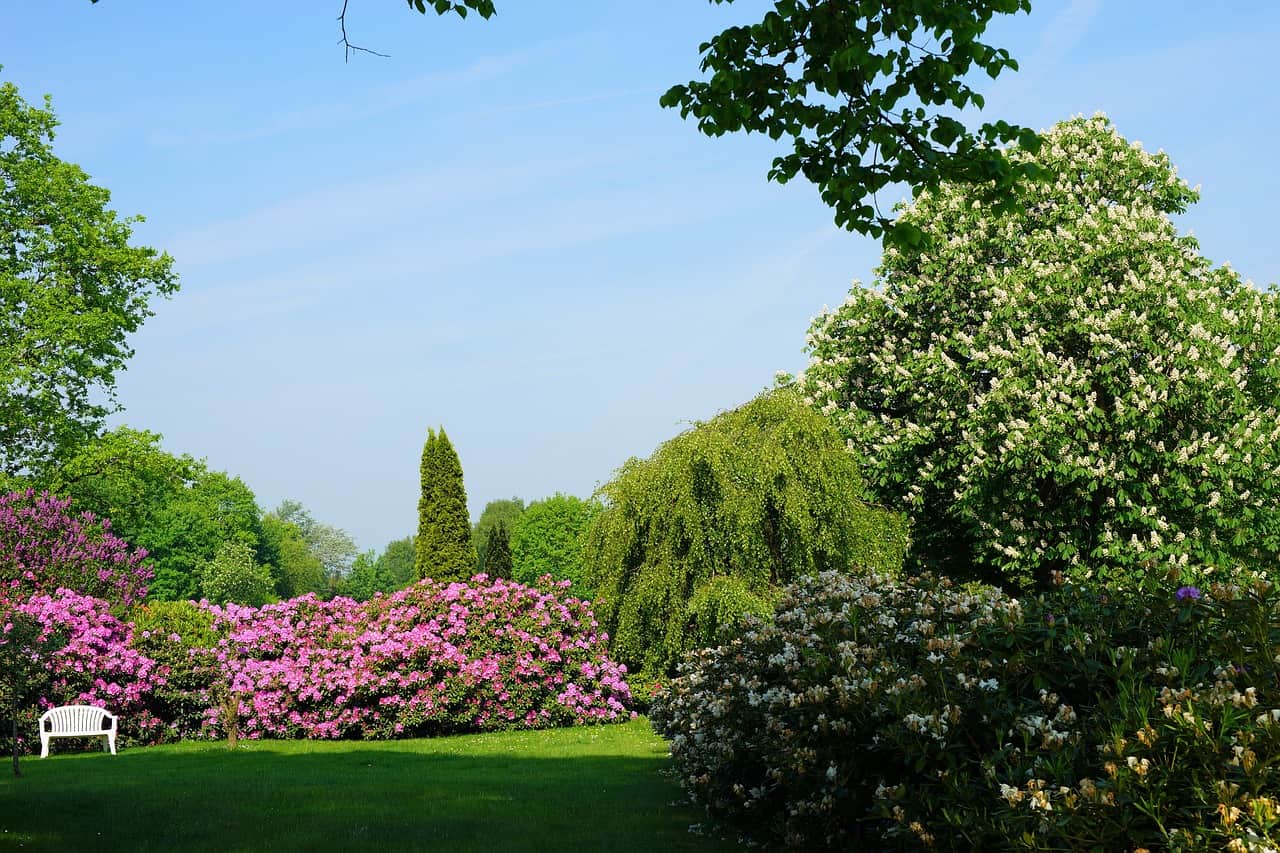If you have a spot in your garden that gets full sun—meaning it gets six or more hours of direct sunlight each day—then you’ll want to choose shrubs that can tolerate and even thrive in those conditions. Here are five of the best full sun shrubs for your garden.
Gold Mound Spirea (Spiraea japonica ‘Gold Mound’)
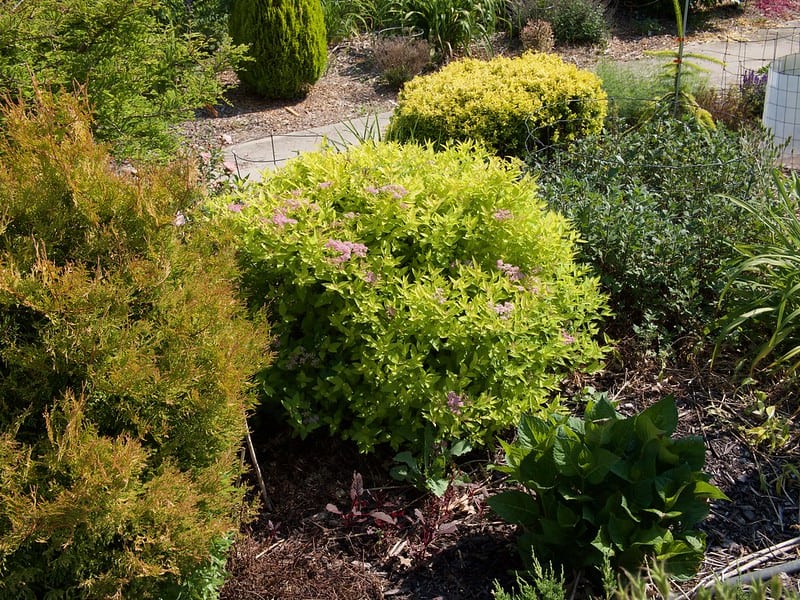
A low-growing shrub that tops out at around three feet, Gold Mound Spirea is an excellent choice for borders, foundation plantings, and mass plantings. It’s also deer-resistant, which is a bonus if you live in an area where deer are a problem. Gold Mound Spirea has bright gold foliage that turns orange and red in the fall. It blooms in late spring or early summer with clusters of white flowers. Gold Mound Spirea is hardy in zones 4-8.
Flamingo Willow (Salix integra ‘Flamingo’)

With its bright pink stems and leaves, Flamingo Willow is sure to add some color to your garden. It’s a fast-growing shrub that can reach up to 15 feet tall and 10 feet wide, so it’s perfect for screening or backdrops. If you live in a colder climate, you can grow Flamingo Willow as an annual; just be sure to bring it indoors before the first frost. Flamingo Willow is hardy in zones 4-7.
Diabolo Ninebark (Physocarpus opulifolius ‘Diabolo’)

A versatile shrub that’s perfect for both formal and informal gardens, Diabolo Ninebark grows anywhere from six to 10 feet tall and wide. It has deep purple foliage that contrasts beautifully with its white flowers, which appear in early summer. Diabolo Ninebark is easy to care for and tolerant of a variety of soil conditions. It’s also resistant to deer and rabbits—an added bonus if you live in an area where these critters are a problem. Diabolo Ninebark is hardy in zones 3-7.
Dwarf Fothergilla (Fothergilla ‘Mount Airy’)
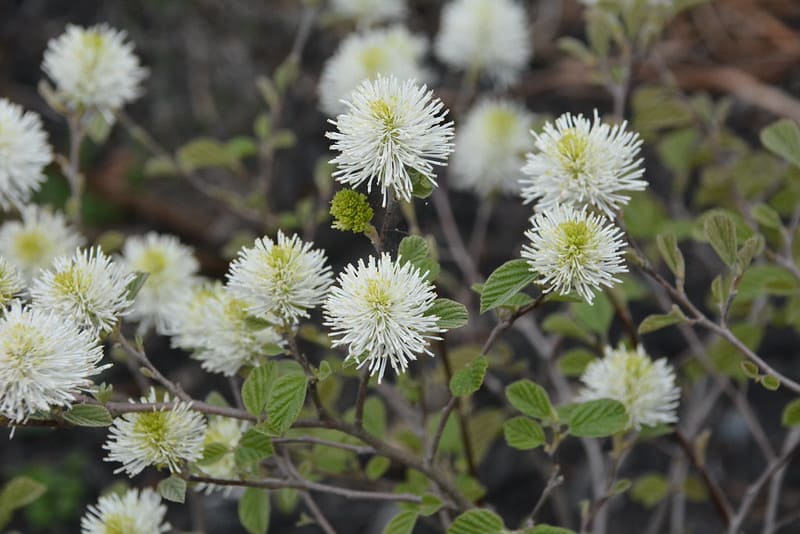
A small deciduous shrub that only grows to about three feet tall, Dwarf Fothergilla is perfect for foundation plantings, rock gardens, or fronts of borders. In spring, it’s covered in white bottlebrush-like flowers; in fall, its foliage turns shades of orange, yellow, and red. Dwarf Fothergilla is easy to care for and tolerant of a variety of soil conditions. It’s also deer-resistant and rabbit-resistant—an added bonus if you live in an area where these critters are a problem. Dwarf Fothergilla is hardy in zones 5-8.”
Oakleaf Hydrangea (Hydrangea quercifolia)
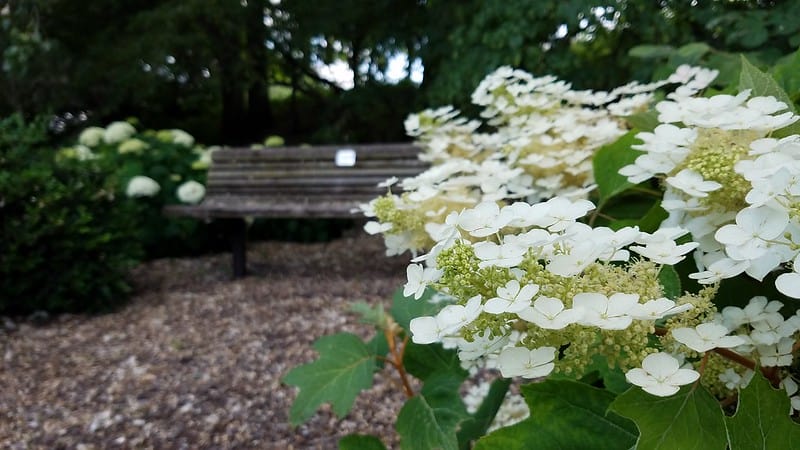
A deciduous shrub that typically grows anywhere from six to eight feet tall (although it can sometimes reach heights of up to 12 feet), Oakleaf Hydrangea is perfect for foundation plantings or mixed borders. It has large oak-shaped leaves that turn shades of red, purple, and bronze in the fall; in late spring or early summer, it produces clusters of white flowers. Oakleaf Hydrangea is easy to care for and tolerant of a variety of soil conditions; it does best in moist soils but can also tolerate drought conditions once it’s established.”
Tiger Eyes Staghorn Sumac (Rhus typhina ‘Bailtiger’)
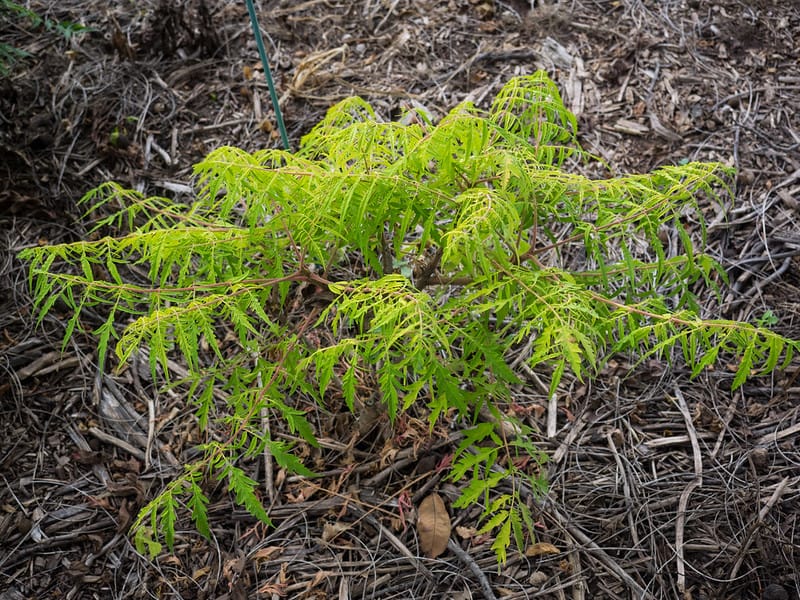
This eye-catching shrub has yellow and orange leaves that resemble a tiger’s eye. It is a fast grower and can reach up to 15 feet tall. It is tolerant of most soil types as long as it is well-drained.
Rock Cotoneaster (Cotoneaster horizontalis)
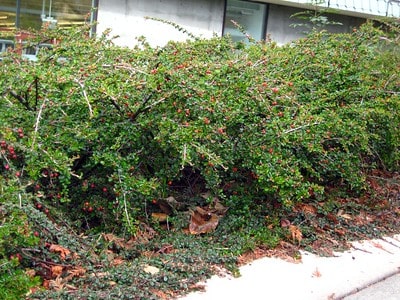
This spreading shrub has small white flowers that bloom in the spring, followed by red berries in the fall. It grows 6-10 feet tall and 10-15 feet wide. It prefers well-drained soil and does not tolerate wet conditions.
Beautyberry (Callicarpa americana)
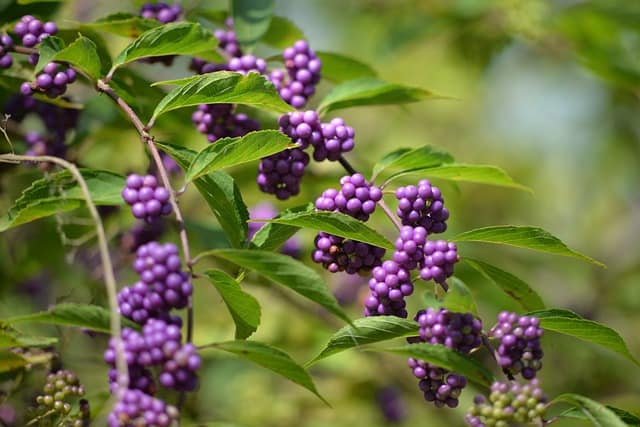
This deciduous shrub is native to North America and grows 6-9 feet tall. In the fall, the leaves turn a beautiful yellow color. The highlight of this shrub is the bright purple berries that appear in the late summer and early fall. Beautyberry prefers moist, well-drained soil but can tolerate dry conditions.
Pussy Willow (Salix discolor)
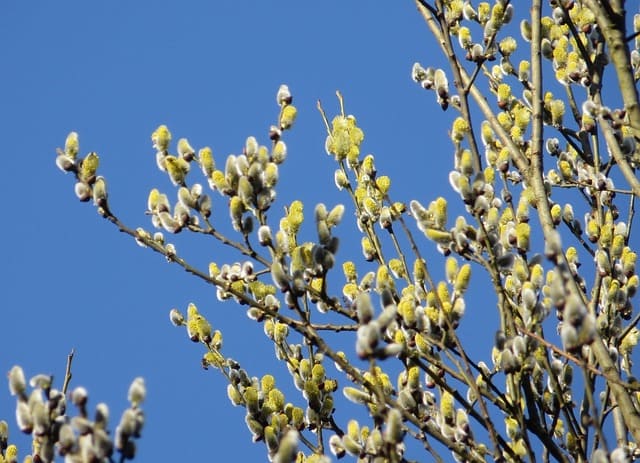
As its name suggests, this shrub has soft, furry catkins that appear in early spring before the leaves emerge. It grows 10-15 feet tall and wide and prefers moist, fertile soils. Pussy willow is tolerant of occasional flooding but does not like extended periods of drought.
Tatarian Dogwood (Cornus alba)

This attractive shrub has dark green leaves that turn red or purple in the fall. In late spring, small white flowers give way to white berries that are enjoyed by birds. Tatarian dogwood grows 6-8 feet tall and wide and prefers moist, well-drained soils. It is tolerant of clay soils as well as light shade.
Japanese Falsecypress ‘Golden Mop’ (Chamaecyparis pisifera ‘Golden Mop’)

As its name suggests, this slow-growing evergreen has golden needles that give it a “mop” appearance. It only grows 1 foot per year and can reach a height of 10 feet. Japanese false cypress prefers moist, well drained soils but can tolerate some salt spray making it a good choice for coastal gardens.
Butterfly Bush (Buddleja spp.)
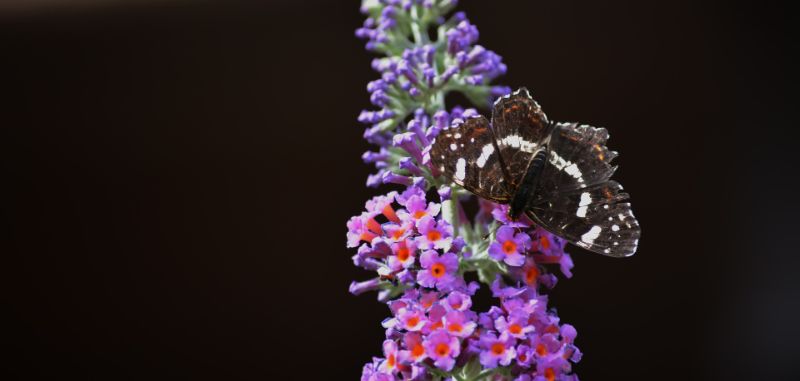
One of the most enticing full sun shrubs is the Butterfly Bush. Known for attracting butterflies (hence the name), this shrub can bloom with a range of colors, including lavender, purple, white, and yellow. Growing up to 6-10 feet tall, Butterfly Bush is often used as a specimen plant due to its size and its ability to create a visual impact.
This drought-tolerant shrub thrives in well-drained soil and can handle poor conditions, making it perfect for a low-maintenance garden. Its long flowering season, often from summer to fall, produces fragrant flowers that can be cut for arrangements or left to attract pollinators. Pruning in late winter encourages fuller growth and abundant blooming.
California Lilac (Ceanothus spp.)
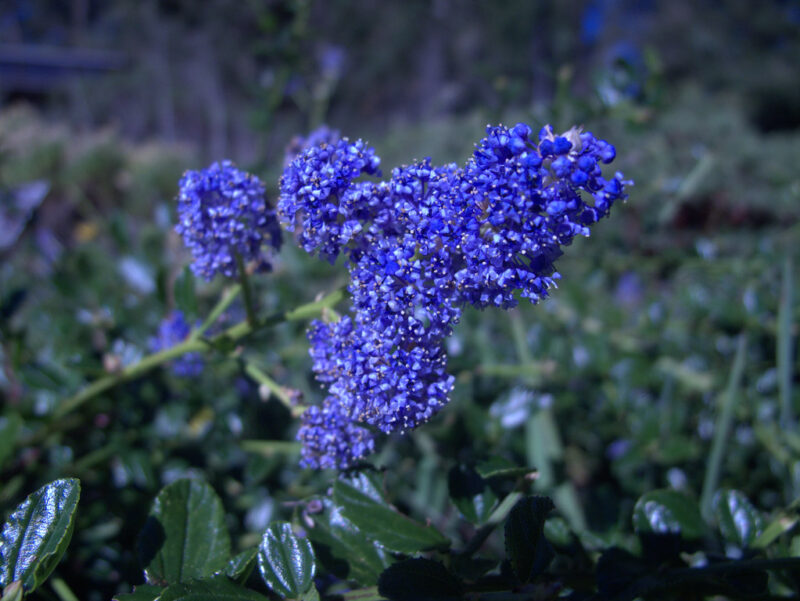
California Lilac, or Ceanothus, is another stunning choice for full sun gardens. Hailing from the western United States, it boasts clusters of bright blue flowers that bloom in spring and attract a myriad of bees, butterflies, and other beneficial insects. This evergreen shrub varies in size, ranging from small ground covers to larger bushes reaching 5 feet or more in height.
California Lilac thrives in well-drained soil and is especially drought-tolerant once established. It’s a perfect pick for xeriscaping and can provide a beautiful contrast to other plants in your garden with its deep green foliage and striking blue blooms. Being suited for full sun, these plants appreciate a sunny spot with plenty of light to shine.
Chaste Tree (Vitex agnus-castus)

Chaste Tree, or Vitex agnus-castus, is celebrated for its aromatic leaves and dense spikes of lavender flowers that attract pollinators. This deciduous shrub can grow up to 10-15 feet tall and wide, making it an excellent choice for creating privacy.
Chaste Tree is remarkably hardy and tolerant of drought, making it ideal for less rainy climates. Its flowering period extends from summer to fall, providing continuous color and fragrance. Beyond its aesthetic appeal, this shrub is also reputed for its medicinal properties, historically used to aid various ailments. Gardeners love it not only for its beauty but also for its versatility and resilience.
Shrubby Cinquefoil (Potentilla fruticosa)
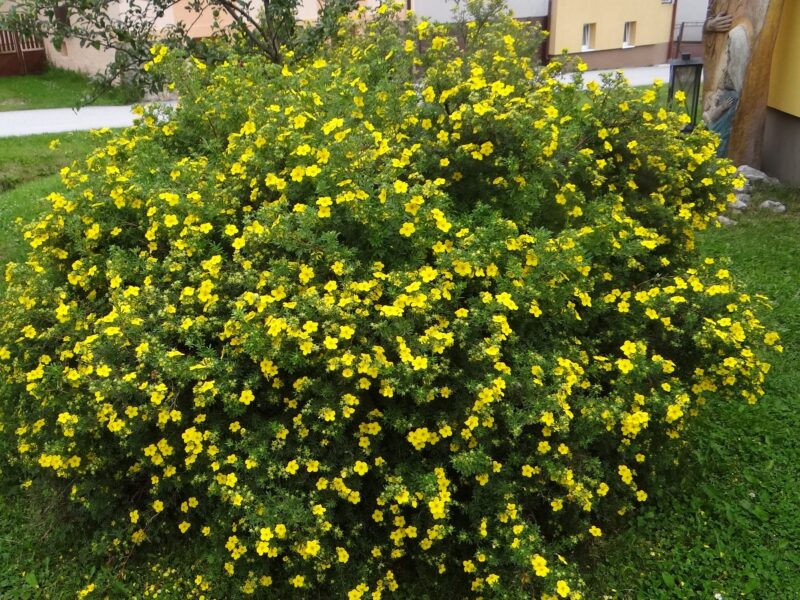
When looking to add easy-care yet beautiful plants to your garden, consider the Shrubby Cinquefoil. This shrub produces bright yellow, white, or pink flowers throughout the summer, transforming any sunny space into a cheerful display. Typically reaching heights of about 3 feet, Shrubby Cinquefoil works well as foundation plantings or border shrubs.
This plant is highly versatile, thriving in various soil types while being drought-resistant once established. With a neat, rounded form, it requires minimal pruning and maintenance, making it accessible for novice gardeners. Its low, sprawling nature also allows it to fit neatly into various landscaping designs, providing year-round interest.
Flowering Quince (Chaenomeles spp.)

The Flowering Quince is a unique shrub known for its vibrant, late-winter to early-spring blooms. With flowers that range from pink to red and even white, this shrub can bring immediate cheer to an otherwise dormant garden. The Flowering Quince also produces small, edible fruits, making it appealing for both ornamental and practical uses.
Typically reaching about 3-6 feet in height, Flowering Quince is suited for full sun and thrives in well-drained soil. It can handle poor soil conditions and limited watering, making it an excellent choice for gardeners looking for low-maintenance options. Plus, the thorny branches provide natural security when used as hedges, deterring unwanted visitors while enhancing overall beauty.
Lantana (Lantana spp.)
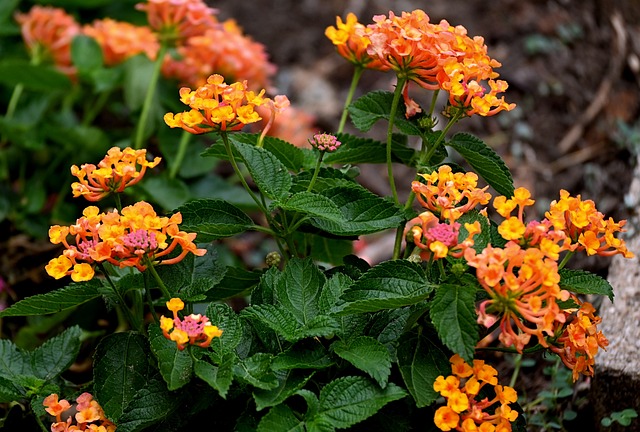
Vibrant and hardy, Lantana is a perennial that thrives in full sun and produces clusters of small, multicolored flowers that can brighten up any landscape. These flowers attract butterflies and hummingbirds, adding dynamic wildlife to your garden.
Lantana can grow as a shrub between 2 to 4 feet tall, depending on the species, and is well known for its drought tolerance. Its ability to thrive in heat and poor soils makes it an excellent choice for gardeners in warmer climates. Additionally, Lantana can be grown as ground cover or as a taller shrub, allowing for flexible landscape designs.
Oleander (Nerium spp.)
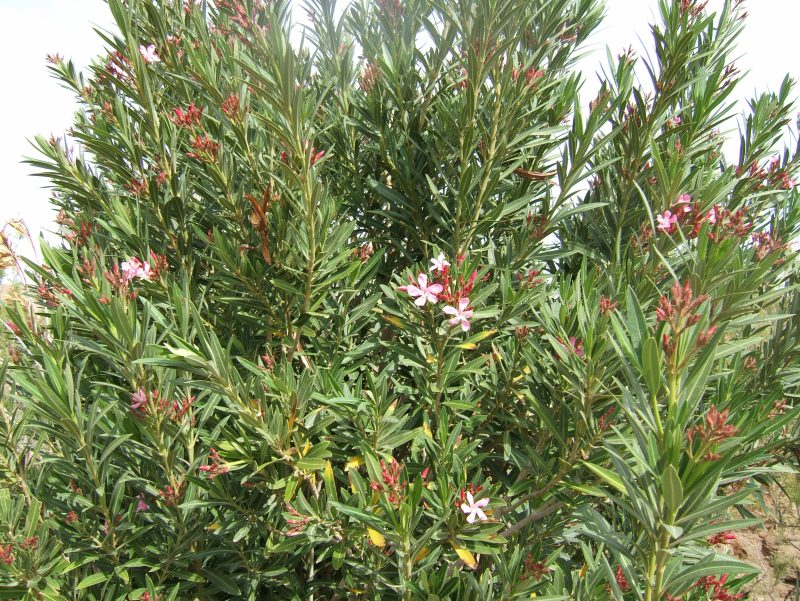
For those in warmer climates craving a dramatic touch, Oleander is a fantastic option. Known for its vibrant flowers in shades of pink, white, yellow, and red, this evergreen shrub can reach heights of 6-10 feet. Oleander blooms profusely during the summer, creating a breathtaking display.
While attractive, it’s essential to note that Oleander is toxic if ingested, so placement is critical, especially in homes with pets and small children. Nevertheless, its drought and heat resistance make it a sturdy choice for full sun gardens, where its lush green foliage can stand out beautifully against harder landscaping elements.
Rockrose (Cistus spp.)
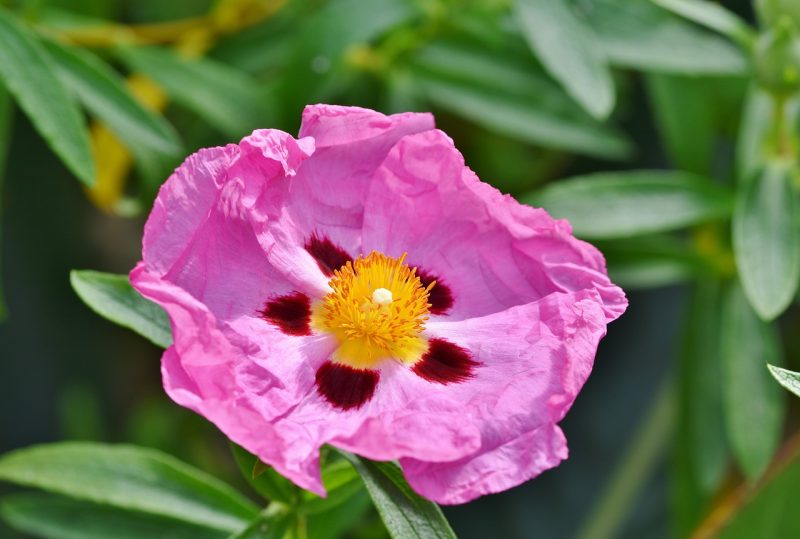
Rockrose, or Cistus, is a group of evergreen shrubs that provides stunning results in sunny gardens. Known for its papery, rose-like flowers, typically in white or pink, these shrubs bloom in late spring to early summer. They thrive in poor, rocky soils and are tolerant of drought, making them ideal for Mediterranean and xeriscape gardens.
Growing up to 3-4 feet tall, Rockrose serves well as a low hedge or in mixed plantings. Its aromatic leaves are attractive to many pollinators, and its resilient nature means it can withstand harsh conditions while looking stunning. With minimal maintenance, Rockrose proves to be a delightful addition with long-lasting beauty.
Rose (Rosa spp.)
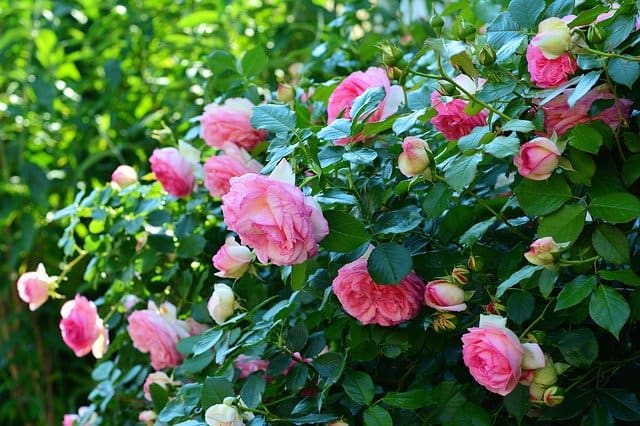
A classic choice for any garden, roses are not just flowers—they can be full sun shrubs too! Depending on the variety, they can grow into bushy plants, climbing vines, or ground covers. Every kind of rose offers something unique, from color to fragrance and bloom style.
Roses love sunlight, needing at least six hours a day to thrive. Their variety means they can fit into different parts of the landscape, from borders to standalone specimens. Additionally, modern rose breeding has resulted in many disease-resistant varieties that can simplify care while still delivering sensational blooms.
Hibiscus (Hibiscus rosa-sinensis)
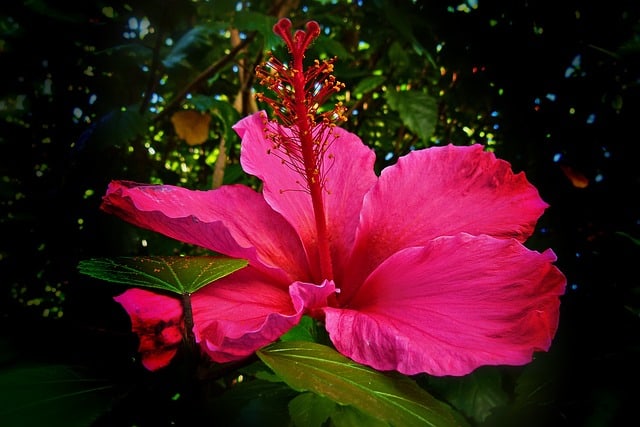
Known for their dramatic, tropical blooms, Hibiscus shrubs bring elegance to full sun gardens. These shrubs feature large, showy flowers in vibrant hues like red, pink, and yellow, which can bloom almost year-round in favorable climates.
Reaching heights of 4-10 feet, Hibiscus provides excellent backdrop plants or focal points in a garden. They require regular watering, especially in hot weather, but their bold blooms create a striking impact. For a timeless tropical vibe, Hibiscus is an excellent choice for those looking to make a statement.
Weigela (Weigela spp.)
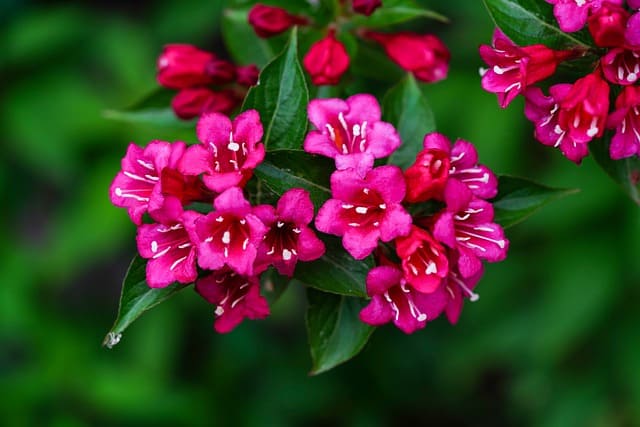
Weigela is another shrub that offers beautiful color in sunny gardens. This deciduous shrub features tubular flowers that hang from arching branches, often in romantic shades of pink, red, or white. Blooming in late spring to early summer, Weigela adds dimension and charm to landscapes.
With a height of 3 to 6 feet, it works wonderfully in informal hedges or as single specimens among perennial flowers. Adaptable to various soil types and conditions, Weigela is fairly low-maintenance and quickly becomes a garden favorite thanks to its enduring beauty and delightful fragrance.
Crape Myrtle (Lagerstroemia indica)
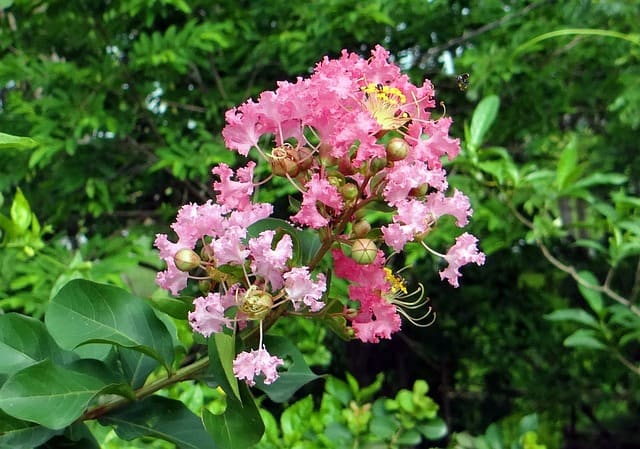
Celebrated for its long-lasting summer blooms, Crape Myrtle has become a staple in many gardens. This full sun shrub can grow up to 15-20 feet tall, depending on the species, and creates a stunning presence with its large clusters of flowers in shades of pink, white, or purple.
Crape Myrtle boasts attractive bark and leaves, providing multi-season interest. It is relatively drought-resistant once established and can handle urban conditions, making it an ideal choice for city gardens. Plus, the fall foliage adds another layer of color as the leaves turn vibrant shades of red and orange.
Spirea (Spiraea spp.)

Spirea is a favorite among gardeners for its ease of care and remarkable blooming habits. Available in various species, these shrubs typically offer clusters of small flowers, often in shades of white or pink, throughout the spring and summer months.
Spirea is a great choice for filling borders and edges, maturing to about 3-5 feet tall. Its adaptability to different soils and ability to flourish in full sun makes it a cherished companion in garden beds. Pruning spent blooms prompt denser growth, meaning better displays year after year.
Glossy Abelia (Abelia x grandiflora ‘Kaleidoscope’)
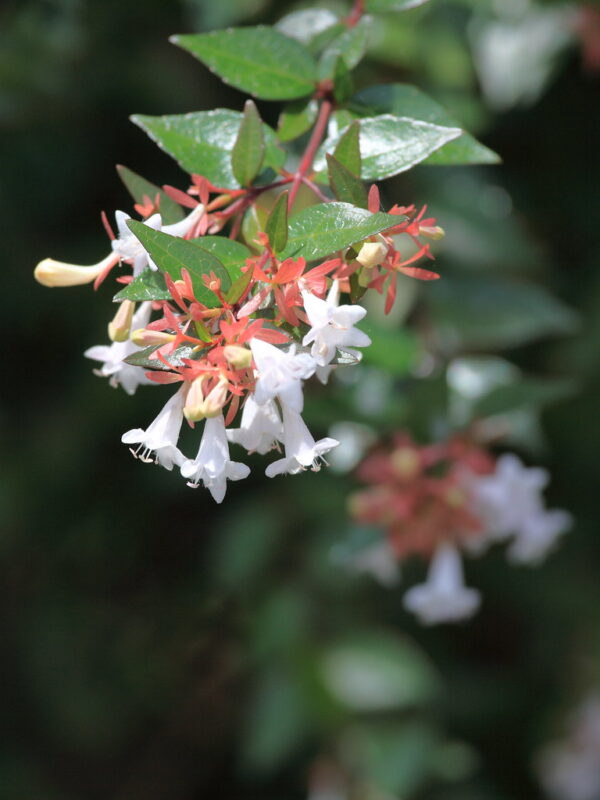
Glossy Abelia is a compact and stunning shrub renowned for its foliage, which changes hues beautifully throughout the seasons. The ‘Kaleidoscope’ variety showcases yellowish foliage during spring and summer, which transitions to oranges and reds in the fall.
Blooms of small white and pink flowers add an appealing softness to its look during summer. Glossy Abelia flourishes in full sun and can adapt to a variety of soil types. Its semi-evergreen character means it maintains its charm throughout the year, connecting seasonal changes in the garden.
Oakleaf Hydrangea (H. quercifolia)

Oakleaf Hydrangea is a unique hybrid that can thrive in full sun, featuring white panicles that bloom in early summer, later maturing to pink as they fade. Its oak-shaped leaves provide further interest, turning a lovely burgundy or maroon in the fall.
Reaching heights of about 4-6 feet, this shrub is perfect for mixed borders or as a specimen plant. It enjoys well-drained and moist soils, and with its drought-tolerant nature, Oakleaf Hydrangea brings floral charm with minimal upkeep. Its seasonal transitions provide a beautiful backdrop throughout the year.
Viburnum (Viburnum spp.)
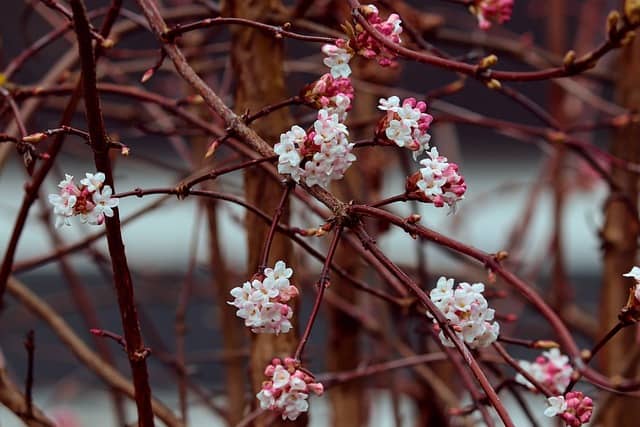
Viburnum is a diverse group of shrubs that can be a beautiful addition to full sun gardens. With numerous species, they can produce a variety of flowers—often creamy white or pink— leading to stunning autumn color displays.
These adaptable shrubs can reach varying heights depending on the type, adding versatility to landscape designs. Viburnums thrive in well-drained soils and can tolerate heat and drought, making them resilient options. Their fragrant flowers and lush foliage invite pollinators into the garden, enhancing its ecological balance.
Dogwood (Cornus florida)
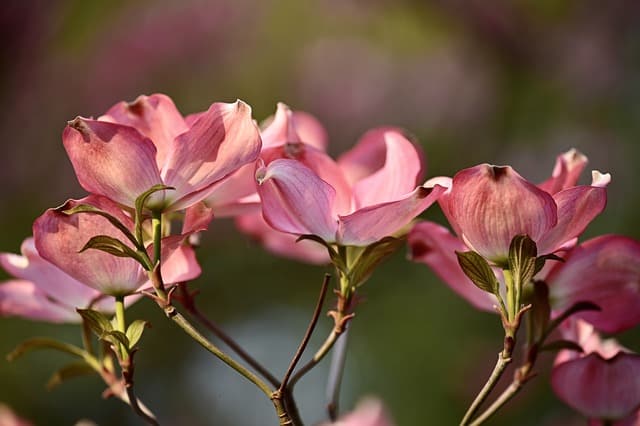
Known for its breathtaking blooms in spring and the vibrancy of red berries in fall, Dogwood is a stunning full sun shrub. This deciduous option reaches heights of up to 30 feet, typically utilized in larger gardens.
Dogwoods shine with showy white or pink flowers that clothe the branches, offering bold contrast against dark green leaves. They appreciate moisture and well-drained soils, providing beautiful landscapes that attract both birds and pollinators throughout the seasons.
Forsythia (Forsythia spp.)
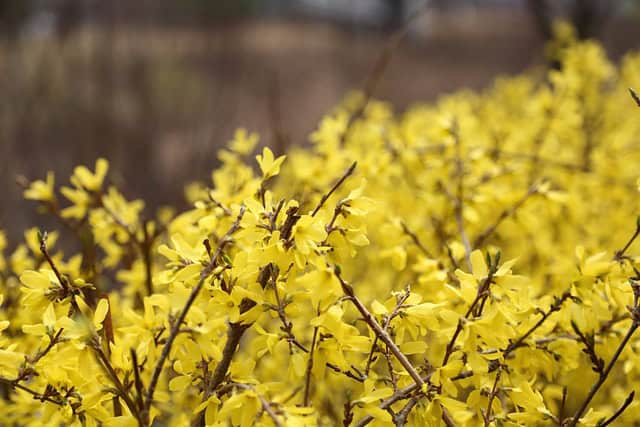
Nothing heralds the arrival of spring better than Forsythia. With its cheerful yellow flowers bursting forth in early spring, this shrub can energize any garden after the long winter months. Forsythia typically grows as a dense hedge, reaching heights of 3-10 feet, depending on the variety chosen.
This hardy shrub thrives in well-drained soil and tolerates a wide range of growing conditions. Once the blooms fade, lush green foliage remains, providing ongoing visual interest through the summer. Pruning after flowering helps maintain its size and encourages fresh growth for the next season—a gardener’s favorite for easy management.
Mock Orange (Philadelphus pubescens)
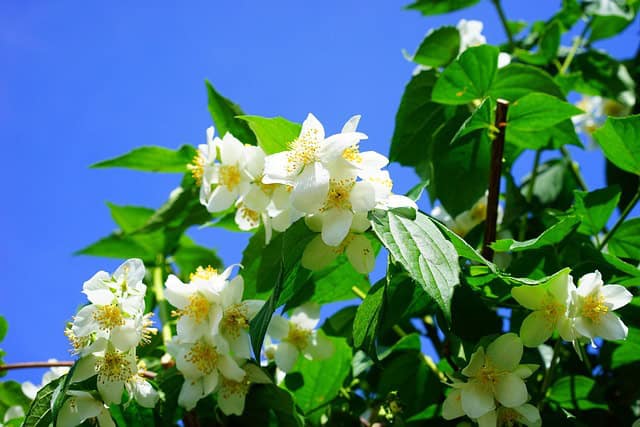
Finally, the Mock Orange is a lovely shrub perfect for full sun. Its delicate white flowers resemble orange blossoms, releasing a captivating scent that will lure you into the garden. Blooms occur in late spring to early summer, creating an attractive display while drawing in pollinators.


